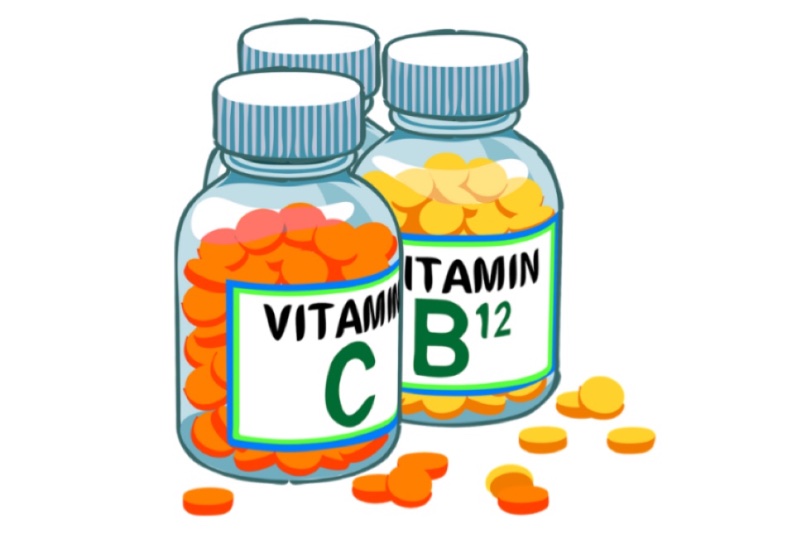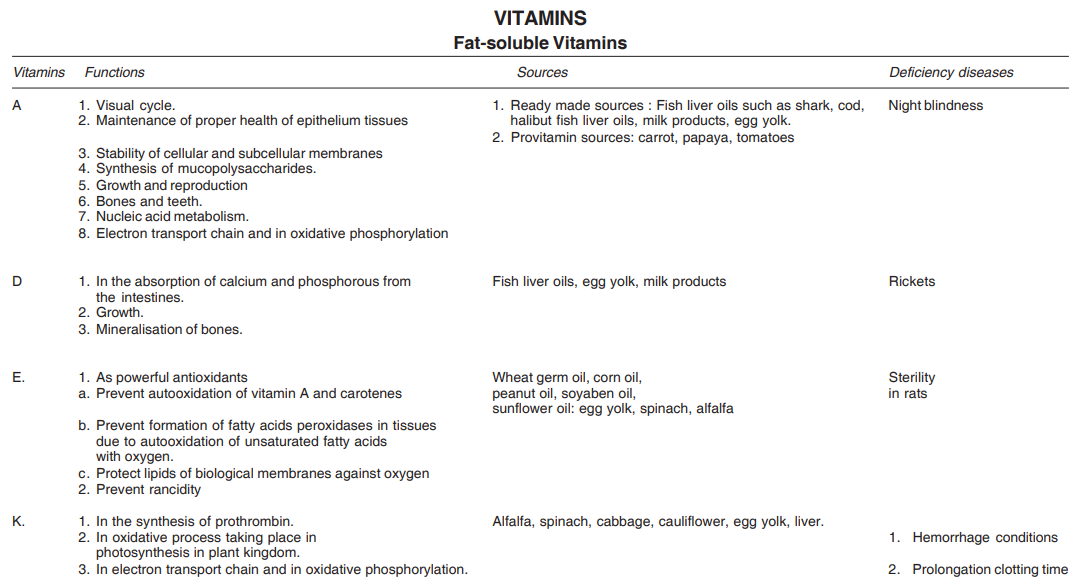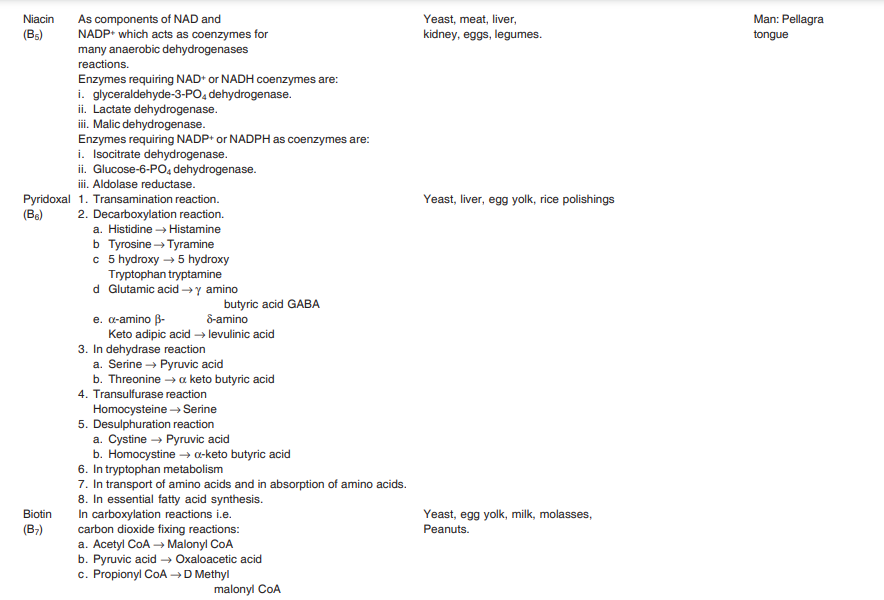
Vitamins (Viva)
Q.1 What are vitamins?
Vitamins are defined as organic substances present in naturally occurring food and are required in small amounts for maintenance, growth, and reproduction.
Q.2. What are the types of vitamins?
Vitamins are two types:
- Fat-soluble vitamins.
- Water-soluble vitamins.
Q.3 What are fat-soluble vitamins?
Fat-soluble vitamins are: Vitamin A, D, E, and K.
Q.4. What are water-soluble vitamins?
Water-soluble vitamins are: i. Vitamin B complex. ii. Vitamin C.
Q.5 What are the members of the vitamin B complex?
- Thiamine (B1)
- Riboflavin (B2)
- Pyridoxine (B6)
- Cyanocobalamin (B12)
- Niacin (B5)
- Pantothenic acid (B7)
- Biotin (B9)
- Folic acid
- Lipoic acid
- Para-aminobenzoic acid (PABA)
- Choline
- Inositol
Q.6 Name the vitamins which are the components of the electron transport chain.
- Niacinamide
- Riboflavin
- Ubiquinone
Q.7 Name the vitamins which are partly synthesized in the intestinal flora.
- Vitamin K
- Thiamine
- Riboflavin
- Pyridoxine
- Niacin
Q.8 What are provitamins?
Provitamins are substances which as such does not possess vitamin activity but on conversion give rise to vitamins.
Provitamins of vitamin A are, a, b, g, carotenes, etc.
Q.9 What are the sources of vitamin A?
Butter, milk, cod liver oil, halibut liver oil, egg yolk, carrots.
Q.10 What is the provitamin form of vitamins A?
Carotenes
Q.11 How many molecules of vitamins A are formed from?
- α-carotenes
- β-Carotenes
- γ-carotenes.
- 1 molecule
- 2 molecule
- 1 molecule
Q.12. What are the functions of vitamin A?
- Visual function.
- Growth and reproduction.
- Proper healing of epithelium.
- Bones and teeth.
- Necessary for the synthesis of mucopolysaccharides.
- It is also involved in nucleic acid metabolism.
- It is also involved in the electron transport chain and in oxidative phosphorylation.
Q.13 What is the daily requirement of vitamin A?
5000 IU
Q.14. What is the deficiency disease associated with vitamin A?
Night blindness
Q.15 What are the active forms of vitamin D?
The active forms are:
1. 25-hydroxycholecalciferol (25 HCC).
2. 1,25 dihydroxycholecalciferol (1,25- DHCC).
Q.16 What are the organs which synthesize the active forms of vitamin D?
Formation of 25-HCC takes place in the liver whereas the formation of 1,25 DHCC takes place in the kidney.
Q.17. What are the precursors of vitamin A?
- Ergosterol: It give rise to calciferol (vitamin D2).
- 7-dehydrocholesterol: It give rise to ergocalciferol (vitamin D3).
Q.18 What are the functions of vitamin D?
- In the absorption of calcium and phosphorus from the intestines.
- Growth.
- Mineralisation of bones.
- Normal functioning of parathormone.
Q.19 What is the daily requirement of vitamin D?
400 IU
Q.20 What are the deficiency symptoms of vitamin D?
- Rickets in children
- Osteomalacia in adults
Q.21 What is hypervitaminosis?
Excessive intake of vitamin A or D gives rise to a condition known as hypervitaminosis.
Q.22. What are the functions of vitamin E?
- As an antioxidant.
- Prevents the autoxidation of vitamin A and carotenes.
- Prevents the formation of fatty acid peroxidases in tissues due to the autooxidation of unsaturated fatty acids with oxygen.
- Protects the lipids of biological membranes against oxygen by acting as antioxidants.
- Prevents rancidity.
Q.23 What are the functions of vitamin K?
- In the synthesis of prothrombin.
- In the oxidative process taking place in the photosynthesis in plant kingdoms.
Q.25 What are the functions of vitamin C?
- In the synthesis of collagen.
- In the synthesis of steroid hormones both in the adrenal cortex and corpus luteum.
- As cofactor in the following reactions:
- In phenylalanine metabolism
p-hydroxy phenyl pyruvic acid→ homogentisic acid.
Dopamine → Norepinephrine.
Folic acid → Folinic acid. - In the synthesis of carnitine in the liver.
- Necessary for the absorption of iron by reducing ferric form to ferrous form.
- In tissue respiration.
Q.26 What are the sources of vitamin C?
Citrus fruits such as lemon, orange, pineapple, etc. gooseberry, green pepper, cauliflower, tomatoes, spinach, potatoes.
Q.27 What is the daily requirement of vitamin C?
60 mg
Q.28 What is the normal level of vitamin C in blood?
0.6-1.5 mg per 100 ml of blood.
Q.29 What is the deficiency disease of vitamin C?
Scurvy
Q.30 Which animal can synthesize vitamin C?
Rat, rabbit, dog, and birds.
Q.31 What is the biologically active form of vitamin B1?
Thiamine pyrophosphate (TPP).
Q.32 What are the functions of vitamin B1?
Thiamine pyrophosphate participates as coenzymes
- In oxidative decarboxylation of α-keto acids.
a. Pyruvic acid→ Acetyl CoA.
b. α-ketoglutaric acid → Succinyl CoA. - In trasketolation reaction of hexose monophosphate shunt pathway.
D-xylulose 5-PO4 + D-ribose 5PO4 ——→ D-sedopheptulose 7-PO4 + D-glyceraldehyde-3- PO4.
Q.33 What is the deficiency symptom of vitamin B1?
Human: Beriberi
Rats: Bradycardia.
Q.34 What are the sources of vitamin B1?
Germinating seeds, legumes, wheat, pork, eggs.
Q.35 What is the daily requirement of vitamin B1?
1.4 gm
Q.36 Why vitamin B2 is also called lactoflavin?
Vitamin B2 was first of all isolated from milk, hence it is called lactoflavin.
Q.37 What are the coenzymes forms of vitamin B2?
- Flavin mononucleotide (FMN).
- Flavin adenine dinucleotide (FAD).
Q.38 What are the various active forms of vitamin B6?
- Pyridoxine
- Pyridoxal
- Pyridoxamine
Q.39 What is the biologically active form of vitamin B6?
Pyridoxal phosphate and pyridoxamine phosphate.
Q.40 What are the reactions mediated by vitamin B6?
1. In transamination reaction
2. In decarboxylation reaction
a. Histidine →Histamine
b. Tyrosine→Tyramine
c. Glutamic acid→γ-aminobutyric acid (GABA)
d. α-amino-β-keto
adipic β-keto adipic acid→δ-aminolevulinic acid.
3. In dehydrases reaction
a. Serine → Pyruvic acid
b. Threonine→ α-ketobutyric acid
4. In transulphurase reaction
Homocysteine→ Serine.
5 .In desulphuration reaction
Cystine pyruvic acid
Homocysteine→ α-Keto butyric acid.
6 .In tryptophan metabolism
Kynurenine→ Anthranilic acid
7. In the transport of amino acids and in the absorption of amino acid.
8. In essential fatty acid synthesis.
Q.41 What are the functions of biotin?
Biotin is required as a cofactor in carbon dioxide fixation reaction.
Carbon dioxide fixation reactions are:
- Acetyl CoA→ Malonyl CoA.
- Pyruvate→ Oxaloacetate.
- Propionyl CoA → Methyl malonyl CoA.
- Formation of Carbamoyl phosphate in the urea cycle.
- In purine skeleton, i.e. C6.
Q.42 What are carbon dioxide fixing or carboxylation reactions?
Carboxylation reactions are those in which a molecule of carbon dioxide is added to produce a carboxyl group.
Q.43 What is the active form of folic acid?
Tetrahydrofolic acid
Q.44 What are the functions of folic acid?
As a carrier of one-carbon moiety.
Q.45 Name one carbon moiety.
- Methyl group (—CH3).
- Hydroxymethyl group (—CH2OH).
- Formyl group (—CHO).
- Formimino group (—CH=NH)
Q.46 Name the reactions mediated by one carbon moiety.
- Ethanolamine → Choline.
- Glycine → Serine.
- Norepinephrine → Epinephrine.
- Guanidoacetic acid → Creatine.
- Uracil → Thymine.
- Ribonucleotides → Deoxyribonucleotides.
- Formation of N-formylmethionine transfer RNA.
- In purine synthesis (i.e. C-2 and C-8 positions in purine skeleton comes from one carbon moiety).
Q.47 What are the sources of folic acid?
Green leafy vegetables, cauliflower, liver, kidney etc.
Q.48 What are the 3 D’s of niacin deficiency?
- Diarrhea.
- Dermatitis.
- Dementia
Q.49 What are the functions of vitamin B12?
- Glutamic acid → β Methyl aspartic acid.
- L-Methyl malonyl CoA → succinyl CoA.
- Ribonucleotides → Deoxy ribonucleotides
Q.51 The increased excretion of the following in the urine is a measure of the deficiency of which vitamins?
- Formiminoglutamic acid
- Methyl malonic acid
- Xanthurenic acid
- Homogentisic acid
- Pyruvic acid.
1. Folic acid.
2. Vitamin B12.
3. Vitamin B6.
4 .Ascorbic acid.
5. Thiamine
Q.52 What is the deficiency disease of vitamin B12?
Pernicious anemia.
Q.53 What are the sources of vitamin B12?
Liver, kidney, meat, milk, cheese
Q.54 Which vitamin is present in coenzyme A?
Pantothenic acid
Q.55 What is scurvy?
It is poor wound healing, easy bruising, bleeding gums, bleeding time, and painful glossitis. It can ultimately lead to anemia.
Q.56 What are the deficiency of folic acid?
Megaloblastic anemia.
Hemocystinemia
Deficiency in early pregnancy causes neural tube defects in the fetus.
Q.57 Who are the people more affected by Folic acid deficiency?
Alcoholics
Pregnant women in their early pregnancy.
Q.58 Name the proteins undergoing Vit K-dependent carbonylation?
Coagulation factors II, VII, IX, X, and protein C and S.
Q.59 What are the deficiency of Vit K?
- Fat malabsorption which can lead to bile duct occlusion.
- Prolong treatment with broad-spectrum antibiotics supply of Vit K by killing intestinal bacteria.
- Breast-fed newborns as mother milk is very low in Vit K.
- Home births where babies were not given Vit K. injections
- Infants whose mothers were treated with anticonvulsants during pregnancy.
Q.60 Name some anticoagulants?
Warfarin, dicumarol, heparin.
Q.61 Sources of Vit D?
Sunlight is a very good source of Vit D.
Vit D3 is found in salmon (saltwater fish) and egg yolks.




Also read: Biochemistry Questions & Answers

Comments (0)